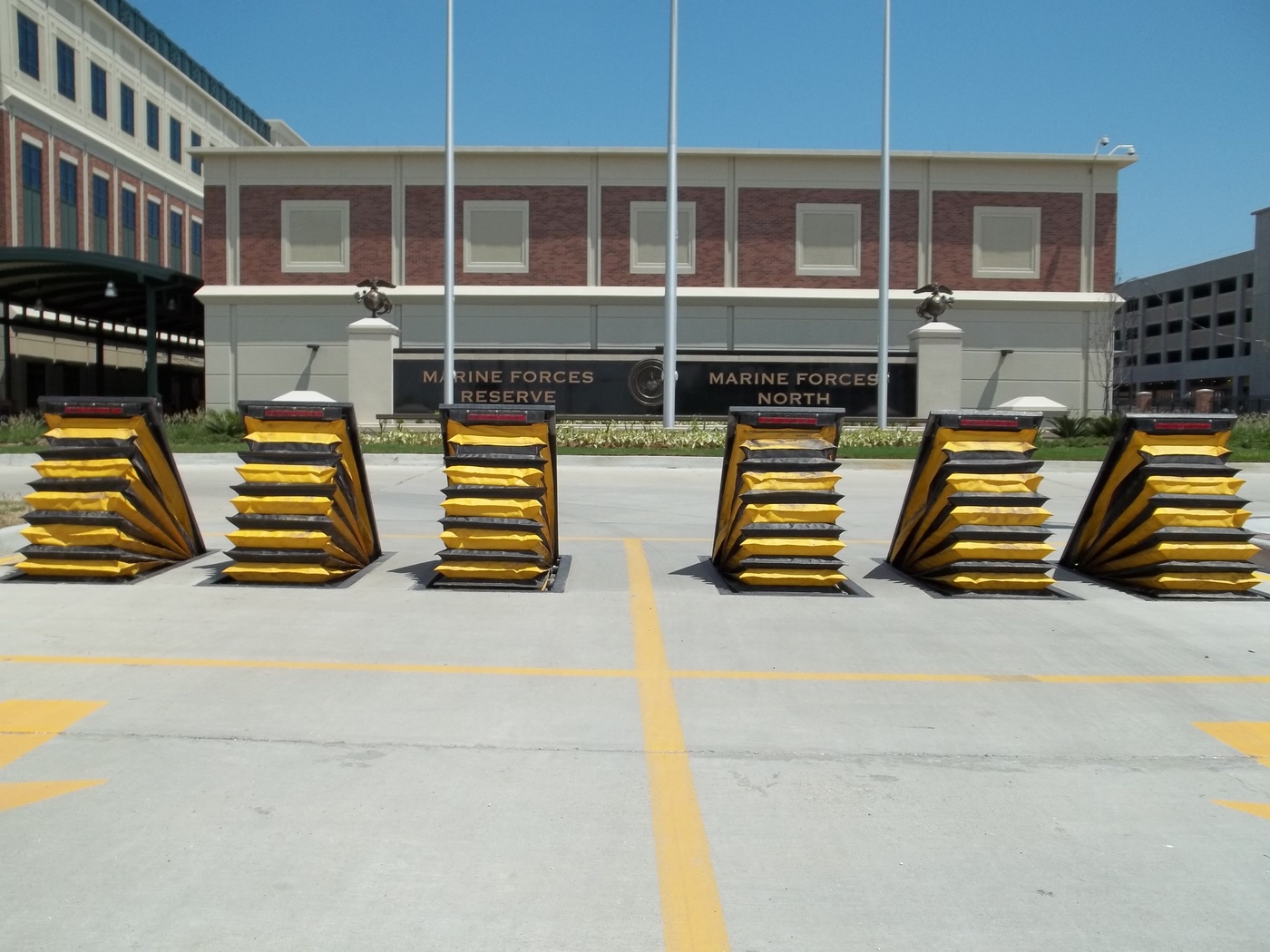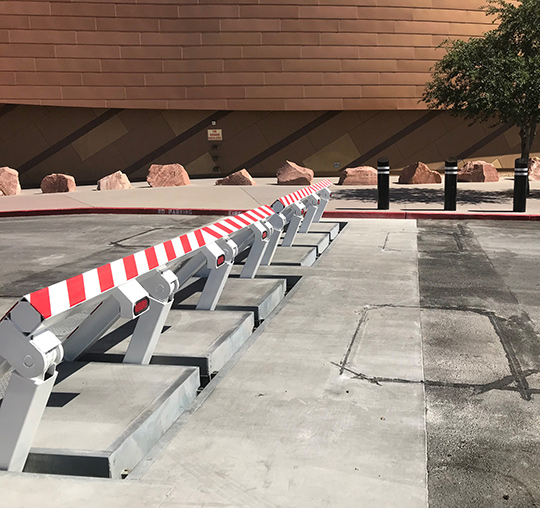Wedge Barriers for Dummies
Table of ContentsSome Of Wedge BarriersThe Definitive Guide for Wedge Barriers

14 and the surface 12 to which the obstacle 10 is secured might be made from concrete - Wedge Barriers. 2, the obstacle 10 is installed to or consists of a support or subframe (e. g., support 30 displayed in FIG. 2 )protected beneath the surface 12. The bather 10 may be bolted to the anchor or secured to the anchor by various other mechanical fasteners. In the detailed embodiment, the barrier 10 consists of a wedge plate 16, which includes a section that is significantly identical with the surface 12 when the barrier 10 remains in the withdrawed position. In various other words, vehicles or people might overlook the barrier 10 when the obstacle 10 remains in the retracted placement and experience small elevation about the surface area 12 while on the obstacle 10. As talked about carefully below, when the obstacle 10 is in the deployed position, the wedge plate 16 is held and sustained in a raised setting by a lifting device of the barrier 10. Additionally, the parts 18 might be bolted or otherwise mechanically paired to one an additional. In this fashion, repair work or substitute of one or even more elements 18 may be simplified and structured. That is, repair work or replacement of solitary elements
18 might be done quicker, conveniently, and expense successfully. FIG. In particular embodiments, the anchor 30 might be a steel frame including plates, beams(e. g., I-beams ), and/or various other structures that are secured within the structure 14, which may be concrete. At the surface 12, a top side 28 of the anchor 30 might go to least partly subjected
, consequently enabling the accessory of the obstacle 10 to the anchor 30. g., threaded holes)in several beams or plates of the support 30 may be subjected to the surface 12. In this way, screws 32 or other mechanical fasteners may be used to secure the barrier 10 to the anchor 30. As the barrier 10 is installed to the surface area 12 of the foundation 14, collection of particles and various other material beneath the barrier might be decreased, and parts of the bather 10 may not be subjected to listed below grade environments. As suggested by referral numeral 52, the training system 50 includes parts disposed under the wedge plate 16. The parts 52 underneath the wedge plate 16 may include an electromechanical actuator, a web cam, one or more web cam surfaces, and so forth. In addition, the lifting system 50 consists of a springtime assembly 54
The spring rod 58 is paired to a web cam(e. g., camera 80 received FIG. 4) of the training system 50. The springtimes 60 disposed about the spring pole 58 are held in compression by spring supports 62, including a taken care of spring assistance 64. That is, the set spring support 64 is repaired about the structure 14 and the rest of the bather 10.
Wedge Barriers Things To Know Before You Buy
g., spring assistance 65 )might be repaired to the end of the springtime rod 58 to allow compression of the springs 60. As the springs 60 are pressed in between the spring sustains 62, the springtime assembly 54 produces a force acting on the camera combined to the spring rod 58 in a direction 66. The staying force applied to
the cam web cam deploy the wedge plate 16 may be provided supplied an electromechanical actuator 84 or other actuator. The spring assembly 54 and the actuator 84(e. g., electromechanical actuator)may run with each other to translate the camera and lift the address wedge plate 16.
As discussed above, the springtime assembly 54 applies a continuous pressure on the cam, while the electromechanical actuator may be managed to apply a variable pressure on the web cam, thus allowing the training and lowering( i. e., deploying and withdrawing )of the wedge plate 16. In specific embodiments, the consistent force applied by the springtime assembly 54 may be flexible. g., electromechanical actuator) is disabled. As will certainly be appreciated, the spring setting up 54 may be covered and protected from why not look here debris or other aspects by a cover plate(e. g., cover plate 68 displayed in FIG. 4) that may be significantly flush with the elevated surface area 38 of the structure 14. As pointed out over, in the deployed setting, the wedge plate 16 serves to obstruct access or traveling beyond the obstacle 10. For instance, the barrier 10(e. g., the wedge plate 16 )may block pedestrians or vehicles from accessing a building or pathway. As discussed over, the obstacle 10 is attached to the anchor 30 safeguarded within the foundation 14,

front braces 71. Because of this, the linkage assemblies 72 may pivot and revolve to allow the collapse and extension of the link assemblies 72 during retraction and implementation of the bather 10. The affiliation settings up 72 cause motion of the wedge plate 16 to be limited. If a vehicle is traveling in the direction of the released wedge plate 16(e. For example, in one scenario, the security legs 86 might be extended duringmaintenance of the barrier 10. When the safety and security legs 86 are released, the safety and security legs 86 sustain the weight of the wedge plate 16 against the surface 12. As an outcome, the lifting mechanism 50 Continue may be deactivated, serviced, removed, replaced, etc. FIG. 5 is partial viewpoint sight of a personification of the surface-mounted wedge-style obstacle 10, highlighting the cam 80 and the webcam surfaces 82 of the lifting system 50. Especially, 2 webcam surfaces 82, which are described as reduced webcam surface areas 83, are positioned listed below the camera 80. The reduced webcam surface areas 83 may be dealt with to the surface area 12 (e. As an example, the lower web cam surfaces 83 and the placing plate 85 may create a solitary piece that is secured to the anchor 30 by bolts or various other mechanical fasteners. Additionally, two camera surfaces 82, which are described as upper camera surfaces 87, are placed above the web cam 80 and combined to (e. In various other personifications, stepping in layers or plates might be positioned in between the surface 12 and the reduced camera surface areas 83 and/or the wedge plate 16 and the top web cam surface areas 87 As pointed out above, the web cam
80 equates along the cam surface areas 82 when the wedge plate 16 is lifted from the retracted position to the released position. Additionally, as discussed over, the spring assembly 54 (see FIG. 3 )may offer a force acting on the camera 80 in the instructions 102 by means of springtime rod 58, which might decrease the force the electromechanical actuator 84 is required to relate to the cam 80 in order to activate and lift the wedge plate 16. 1 )to the deployed placement(see FIG. 4). As revealed, the web cam 80 includes track wheels 104(e. g., rollers), which contact and translate along the web cam surface areas 82 during operation.